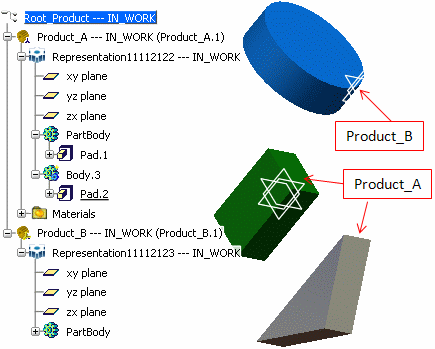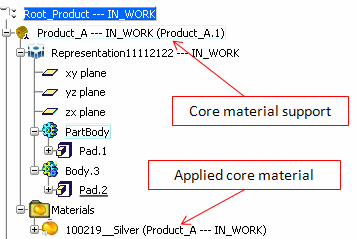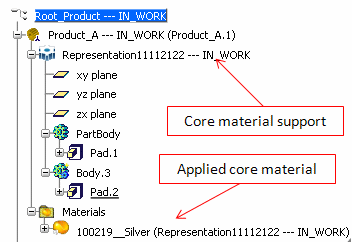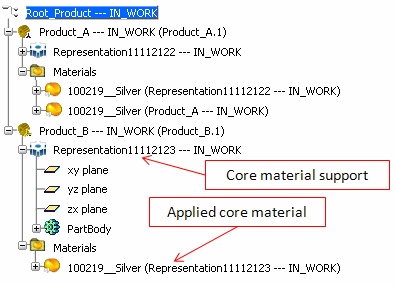About the Material Balloon Toolbar | |||||
|
| ||||
The balloon toolbar appears during material application when you select geometry, a 3D representation, an element within a 3D shape, or a product from either the model geometry (also referred to as 3D) or the specification tree. Initially the balloon is displayed in an inobstrusive low-light mode, but it becomes more visible if you hover over it. The options in the balloon depend on both the current support selection and the selected material's type (core or covering).

Once you select an element either in the model geometry or in the specification tree, the selected material is applied. The balloon toolbar allows you to modify the material's application. You can undo the material application or change the support to which the material is applied (with respect to the rules associated with material application). See About Applying Materials.
The Apply Down![]() and Apply Up
and Apply Up ![]() options allow you to select either the nearest upper or nearest lower valid element in the selection path. The selection path is created as you select an element either in the 3D or in the
specification tree. It comprises the selected element and its parents within the product structure. The selection path appears in the status bar and is limited to three levels. The examples below show the content of the selection path in the model geometry and in the specification tree.
options allow you to select either the nearest upper or nearest lower valid element in the selection path. The selection path is created as you select an element either in the 3D or in the
specification tree. It comprises the selected element and its parents within the product structure. The selection path appears in the status bar and is limited to three levels. The examples below show the content of the selection path in the model geometry and in the specification tree.
If you select an element (Representation_A) in the specification tree, the content of the selection path extends up to this selected element: Representation_A/Product_A.1/Root_Product
If you select an element in the 3D, the content of the selection path extends from the top of the product structure to the lowest valid element to which you can apply a material in the product structure: PartBody/Representation_A/Product_A.1
To change the support, click the arrow of interest. The previous application is cancelled and the material is applied again.
The selection path determines the possible supports that can be used with Apply Up and Apply Down options. By default, the first time the material is applied to the product that is contained in the selection path. Then, you can use Apply Down or Apply Up to change the support to which you apply the material.
The material's application is committed in the three following situations:
- If you press Esc or
 .
. - If you select another material in the palette.
- If you select another geometry by clicking a new support in the specification tree or in the 3D.
The Undo option ![]() allows you to remove the material you last applied. The Undo tool in the balloon is similar to the Undo tool in the Edit menu (see Reversing Actions in the Infrastructure User's Guide for more information).
allows you to remove the material you last applied. The Undo tool in the balloon is similar to the Undo tool in the Edit menu (see Reversing Actions in the Infrastructure User's Guide for more information).
| Important: The standard Undo/Redo options and the corresponding shortcuts are disabled when the application mode is active. |
The Stop Balloon option ![]() allows you to close the ballon toolbar. Alternatively, you can press Esc. Select a material in the palette to continue the material application.
allows you to close the ballon toolbar. Alternatively, you can press Esc. Select a material in the palette to continue the material application.
![]()
Example
Consider the following product structure:

If you apply a core material (silver) to Product_A in the 3D selecting the triangular pad, both the balloon toolbar and message appear. The message indicates the current material support and the material type. The selection path appears in the status bar:Body.3/Representation11112122/Product_A

If you click Apply Down![]() , the core material is applied to the representation instance under Product_A. The new core material support (Representation11112122) is identified both in the message and the specification tree.
, the core material is applied to the representation instance under Product_A. The new core material support (Representation11112122) is identified both in the message and the specification tree.

If you select Product_B in the 3D by selecting the blue cylinder pad, the core material is applied to the representation instance (Representation11112123). Representation instance was the type of the last support to which a material was applied. The selection path appears in the status bar: PartBody/Representation11112123/Product_B

Note: The application mechanism is similar for covering materials if you use the Materials palette.